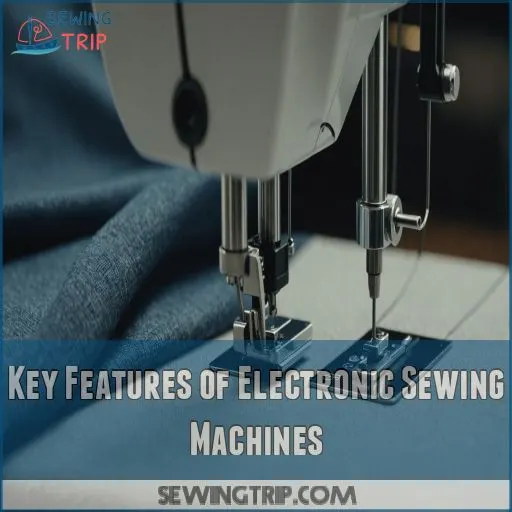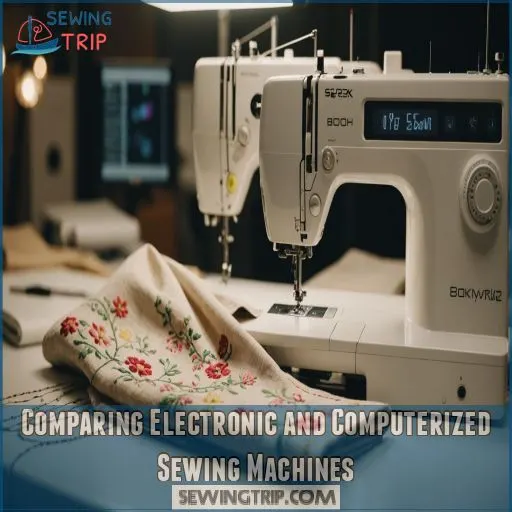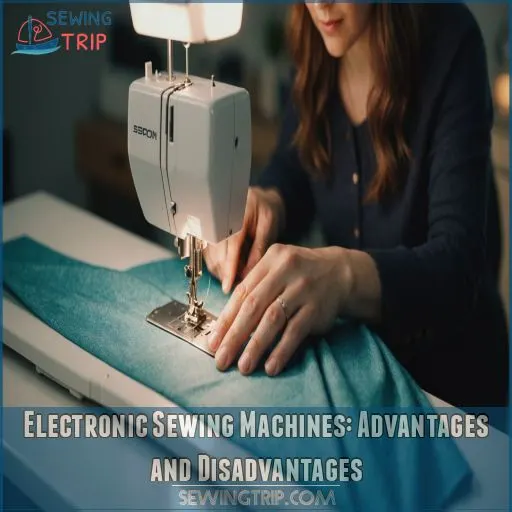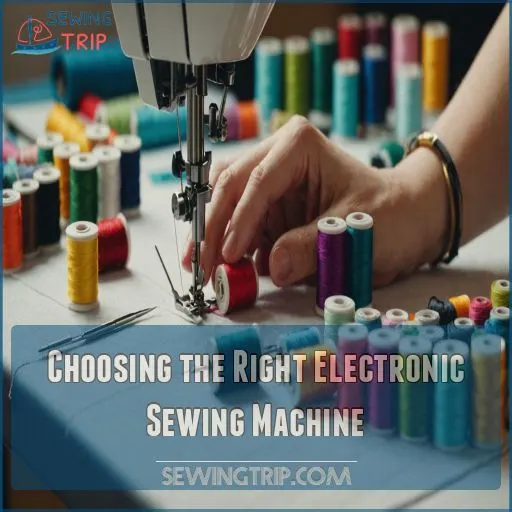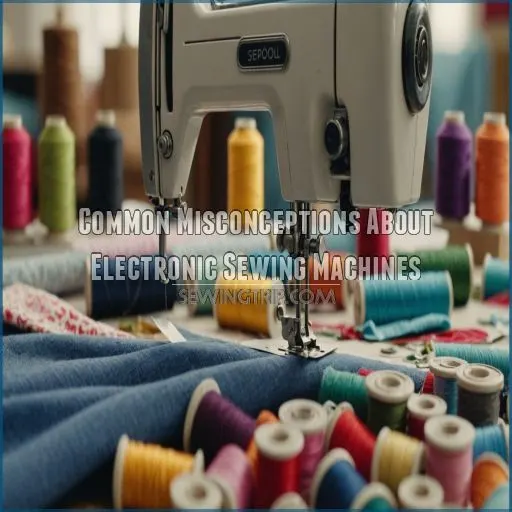This site is supported by our readers. We may earn a commission, at no cost to you, if you purchase through links.
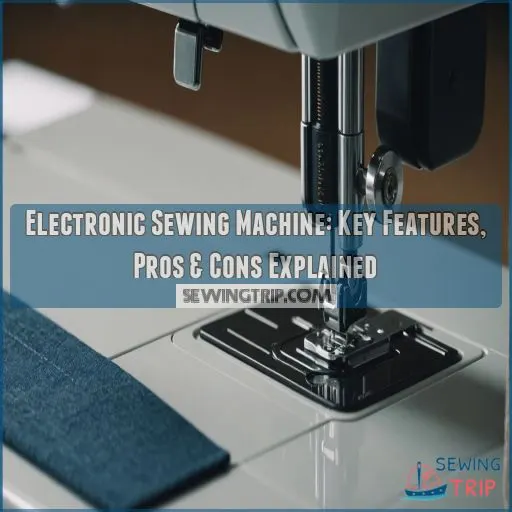
Think of it as your sewing superpower, minus the cape!
Unlike traditional mechanical machines, this one’s got electronic components that let you effortlessly choose stitches, control speed, and sometimes even adjust tension.
If you’re new to sewing or just looking for a hassle-free experience, you’ll love its simplicity and affordability. It won’t sew on its own (you’re the hero here!), but it sure makes learning a breeze.
Ready to stitch? Up next: unravel the secrets of finding the perfect machine for you, and discover how to make the most of its hassle-free experience!
Table Of Contents
- Key Takeaways
- Key Features of Electronic Sewing Machines
- Comparing Electronic and Computerized Sewing Machines
- Electronic Sewing Machines: Advantages and Disadvantages
- Choosing the Right Electronic Sewing Machine
- Common Misconceptions About Electronic Sewing Machines
- Debunking the Less Durable Myth
- Addressing Concerns About Complexity and Ease of Use
- Separating Facts From Fiction About Electronic Machines
- Real-World Examples of Successful Electronic Machine Users
- Expert Insights and Recommendations
- Are electronic sewing machines, like those with 130 built-in stitches, better than digital sewing machines
- Why is my sewing machine skipping stitches and what role does having the right stitch options and variety play in preventing this issue
Key Takeaways
- You won’t need a cape, but an electronic sewing machine will be your sewing sidekick, with features like automated stitches and speed control, making sewing feel less like a chore and more like a creative adventure.
- If you’re new to sewing or just want a hassle-free experience, these machines are perfect. They’re easy to use and won’t break the bank, like finding a fancy coffee table at a garage sale price.
- Unlike your grandma’s old sewing beast, electronic machines offer simplicity with a modern touch, giving you easy controls and reliable durability. They’re that comfy pair of sneakers that lets you take on sewing projects without the blisters.
- While they might not have all the bells and whistles of their computerized cousins, electronic machines are fantastic for basic projects, ensuring you can master the essentials without feeling as though you’re operating a spaceship.
Key Features of Electronic Sewing Machines
If you’ve ever wished for a sewing machine that blends simplicity with a little bit of modern flair, electronic sewing machines might just be your perfect match.
They’re like that reliable friend who won’t break the bank but still helps you tackle those creative sewing projects with basic built-in stitches and easy speed control.
Built-in Stitches and Speed Control
Get ready to explore electronic sewing machines, where stitching becomes an art form. These marvels boast built-in stitches and speed control for precision and creativity.
Imagine this:
- Stitch Types: Choose from hundreds.
- Speed Control Settings: Seamlessly adjust.
- Stitch Customization: Tailor with flair.
- Foot Pedal Control: Step on it!
Unleash your inner artist with every thread.
Limited Automatic Features
Using limited automatic features in an electronic sewing machine can feel like a walk in the park. You’ll often adjust manual needle threading and tension control—think of it as a dance with the machine.
| Feature | Manual Control | Automatic Feature |
|---|---|---|
| Needle Threading | Yes | No |
| Tension Control | Yes | No |
| Buttonhole Making | Partial | Yes |
Enjoy mastering your craft!
Simple Controls and Durability
Electronic sewing machines offer a great combination of simplicity and durability. You’ll find them reliable and user-friendly, perfect for enhancing your sewing experience.
They’re comparable to mechanical machines in terms of ease of use, offering intuitive controls that make them easy to navigate, even for beginners. In fact, choosing between computerized vs mechanical sewing machines is often a key decision for those just starting out.
- Easy Controls: No fuss, just twist and turn.
- Sturdy Build: Think long-lasting friendships.
- Low Maintenance: Save time (and sanity!).
- Affordable Value: Great for your budget.
Suitability for Basic Projects
Choosing an electronic sewing machine for basic projects is like finding your favorite pair of jeans—it just fits.
You get easy controls, making simple stitches and basic repairs a breeze.
It’s the perfect companion for your DIY projects, catering to your sewing ambitions without overwhelming you.
Begin your sewing journey confidently with these beginner-friendly sewing machines guiding your every sewing machine tutorials Sewing Machine Basics
.
Affordability and Beginners’ Options
Affordability is a key factor when choosing an electronic sewing machine, especially for beginners. These budget-friendly options often boast simple controls, limited automatic features, and a focus on durability – perfect for mastering the basics without breaking the bank.
Popular beginner-friendly brands include Brother, Janome, and EverSewn, offering machines under $100 with:
- 15-21 built-in stitches
- Manual stitch selection
- 1-4 step buttonholes
- Front-loading bobbins
- Lightweight, portable designs
Comparing Electronic and Computerized Sewing Machines
If you’re choosing between electronic and computerized sewing machines, understanding their differences can help you make an informed decision.
Computerized machines offer more features and advanced capabilities, but electronic machines are usually more affordable, making them a great option if you’re not ready for the bells and whistles.
Price and Budget Considerations
Picture yourself sewing with ease and savings! In the sewing scene, electronic machines offer budget-friendly options, balancing affordability and features.
Check this table for a quick comparison:
| Attribute | Electronic Machines | Computerized Machines |
|---|---|---|
| Price | Lower | Higher |
| Features | Basic | Advanced |
| Stitch Variety | Limited | Extensive |
| Cost-effective Sewing | High | Moderate |
Enjoy value for money without stitching your wallet!
Ease of Use and Intuitive Interfaces
When eyeing ease of use, electronic sewing machines offer beginner-friendly controls, perfect for straightforward tasks. Their user interface design, though limited in automatic features, provides an intuitive navigation experience. You won’t need a PhD to operate them!
Consider these aspects:
- Familiar manual adjustments
- Simple button navigation
- Short learning curve
- Durable build
- Consistent performance
With these, you’ll sew with confidence!
Stitch Selection and Customization Options
You’ve got many stitch types at your fingertips with an electronic sewing machine. Explore the stitch library, where custom stitch designs await your creative touch.
Unlike computerized models, electronic machines offer fewer stitch editing options and stitch memory capabilities.
However, they’re perfect for mastering the basics without breaking the bank, offering a gentle nudge into sewing freedom .
Automatic Features and Advanced Capabilities
Adjusting stitch length or dealing with tension woes feels like taming a wild machine, doesn’t it?
Automatic features in computerized sewing machines bring sanity back. With automatic needle threading, built-in embroidery designs, and speed control options, it’s like having a sewing butler at your beck and call.
Mastery in sewing suddenly feels like child’s play! (Source)
Connectivity and Digital Features
Craving creativity? Electronic sewing machines spice up your sewing with Internet-connected patterns, app integration, and digital stitch libraries.
Tap into an online community for inspiration, embracing the possibilities that come with technology.
Though not as tech-packed as computerized machines, these features bring a fresh spin, mixing tradition with a dash of digital dazzle.
Smart sewing features for precision and synchronization with your gadgets also play a key role in enhancing the sewing experience.
Electronic Sewing Machines: Advantages and Disadvantages
Are you considering an electronic sewing machine but unsure of its pros and cons?
Let’s take a closer look at the key advantages and drawbacks of these user-friendly machines, so you can make an informed decision that fits your sewing needs and budget.
Pros: Affordability, Simplicity, and Durability
Exploring electronic sewing machines? They’re budget-friendly and perfect for beginners, offering that sweet spot of simplicity and durability. Think of them like a trusty old friend—you’ll love their reliability without breaking the bank.
Check out this table for a quick look at these strengths:
| Feature | Benefit |
|---|---|
| Affordability | Value for money |
| Simplicity | Easy to operate |
| Durability | Long-lasting use |
| Beginner-Friendly | Easy learning curve |
Cons: Limited Stitch Options, Lack of Customization
While electronic sewing machines offer affordability and simplicity, you’re bound to bump into stitch limitations .
With only a handful of built-in options, creative limits can crop up.
- Basic projects: Ideal for beginners
- Sparse customization: Minimal advanced techniques
- Limited upgrading options: Fixed patterns
You might feel like a chef with only salt and pepper at hand, craving more flavor!
Real-World Applications and User Testimonials
Jump into the world of electronic sewing machines, where creativity meets practicality.
Whether you’re jazzing up home decor, crafting quilts, tackling clothing repairs, or exploring beginner sewing projects, there’s a machine made for you.
Users rave about features like intuitive needle controls and handy start/stop buttons that take the stress out of sewing and add a dash of fun.
Comparison With Mechanical and Computerized Machines
You’ve explored real-world applications, now pit electronic machines against both mechanical and computerized counterparts. One’s perfect for quilt-busting, while another might trip over button-holes.
Computerized machines offer a much broader range of built-in stitches, while mechanical models usually provide only basic options such as straight, zigzag, and buttonhole, which can impact stitch variety.
Electronic machines may require a balance between simplicity and complexity, making it important to think about the user’s experience with computer-controlled features.
Finding your match helps you sew happily for a long time.
Upgrades and Maintenance Considerations
Thinking about electronic sewing machine upgrades? Keep your stitches in shape by backing up designs before tinkering . Routine maintenance can save stitches and sanity.
Replacing parts like motors or pedals gives new life, yet make sure compatibility (not all upgrades hit the mark) .
Find parts easily, but remember: some DIY repairs might require a bit of elbow grease or expert hands, and a bit of routine maintenance can save your sanity.
Choosing the Right Electronic Sewing Machine
Choosing the right electronic sewing machine doesn’t have to be a patchwork of confusion.
Focus on figuring out features and budget constraints to find the best fit for your needs.
By researching thoroughly and considering brand reputation, customer support, and warranty options, you’ll be stitching your way to success in no time!
Evaluating Features and Budget Constraints
When choosing an electronic sewing machine, carefully evaluate the features that matter most to you and your budget.
Look for adjustable stitch length and width, a buttonhole function, needle position control, and an integrated free arm – these core capabilities will serve you well, no matter your sewing ambitions.
- Adjustable stitch length and width
- Buttonhole function and foot
- Adjustable needle position
- Integrated free arm
Research and Reviews for Informed Decisions
Before jumping into a purchase, check out user reviews and comparison charts to unearth the best brands and features within your price range.
Feature analysis helps demystify technical jargon, giving you the upper hand. It’s like decoding a sewing pattern—tedious yet rewarding.
Remember, informed decisions lead to sewing mastery without breaking the bank.
Brand Reputation and Customer Support
Diving into sewing machines? A brand’s reputation is like sewing thread—strong, reliable brands like Bernina can smooth the ride!
Stellar customer service is the needle that threads the needle: warranty coverage, repair services, and community feedback are your bobbins of support.
Choose wisely, and you’ll sew with confidence, knowing help is just a call away.
Additional Accessories and Bundle Deals
While brand reputation‘s got your back, don’t underestimate the appeal of bundle deals.
They can be game-changers, offering you essential accessories like foot pedals, sewing machine cases, or nifty storage solutions.
It’s like getting extra toppings on your pizza at no cost! Keep an eye out for those enticing offers to enhance your sewing experience while staying on budget .
Warranty and After-Sales Service Considerations
Even the best sewing machine needs a solid warranty, like a safety net for your creative journey.
Keep your eyes peeled for repair costs, making sure they’re minimal or even covered.
Other key aspects to consider are extended warranties, which are worth the peace of mind, and customer support that is quick and friendly.
Additionally, return policies can be a deciding factor, with flexible ones being a plus.
Lastly, a manufacturer’s reputation is important, as trustworthy brands mean fewer headaches.
- Repair costs: Make sure they’re minimal or even covered.
- Extended warranties: Worth the peace of mind.
- Customer support: Quick and friendly.
- Return policies: Flexible ones are a plus.
- Manufacturer reputation: Trustworthy brands mean fewer headaches.
Common Misconceptions About Electronic Sewing Machines
You might think electronic sewing machines aren’t as durable or are too complex, but that’s just a common myth.
Let’s unravel these misconceptions and explore how these machines offer the perfect blend of simplicity and functionality!
Debunking the Less Durable Myth
The myth that electronic sewing machines lack durability is crafted from myth, not fact. These machines boast impressive lifespans, rivaling heavy-duty models with proper maintenance.
Engage in routine upkeep, and you’ll sew smoothly for years.
| Feature | Electronic Machines | Mechanical Models |
|---|---|---|
| Lifespan | Long-term reliability | Longevity |
| Repair Costs | Lower in some cases | Moderate |
| Maintenance Tips | Regular cleaning | Occasional tunes |
| Durability | Heavy-duty options | Sturdy build |
| User Experience | Automatic, smooth | Manual operation |
Addressing Concerns About Complexity and Ease of Use
Don’t let the fear of complexity hold you back! Electronic sewing machines are designed with beginners in mind, featuring intuitive interfaces and user-friendly controls, which are crucial qualities to consider when choosing the right machine
. With step-by-step tutorials and reliable tech support, you’ll be sewing like a pro in no time. The learning curve is smoother than you think – just get started and enjoy the ride!
- Intuitive controls and clearly marked dials make selecting stitches a breeze.
- Automatic features like needle threaders and thread cutters save time and effort.
- User-friendly manuals and online tutorials provide guidance every step of the way.
Separating Facts From Fiction About Electronic Machines
You might think electronic sewing machines are overly complex or delicate, but that’s not true.
They’re designed with features even beginners can easily master. Imagine having a trusty friend guiding you through stitch by stitch without mishaps.
These machines offer impressive durability and beginner-friendly features, ensuring a smooth sewing experience that balances cost and value perfectly.
Real-World Examples of Successful Electronic Machine Users
Exploring the truths about electronic sewing machines, you’ll find many who flourish in creative ventures. Beginner success stories abound, from crafting DIY fashion to professional quilters mastering intricate designs.
Picture folks upcycling clothing or weaving home decor projects with ease and flair.
These users transform skepticism into threads of triumph and satisfaction, proving the machine’s prowess.
Expert Insights and Recommendations
Gearing up with electronic sewing machines can be intimidating, but don’t let misconceptions sew confusion into your plans.
Experts recommend:
- Choose based on features, not just brand reputation .
- Understand sewing machine maintenance—keep it as smooth as a well-oiled zipper.
- Embrace beginner tips and project recommendations for mastery over metallic beasts .
Equip yourself wisely, and you’ll stitch success in no time!
## Frequently Asked Questions
### What is the difference between mechanical and electronic sewing machines?
Around 70% of beginners choose **mechanical sewing machines** for simplicity and cost-effectiveness.
They choose these machines over others because mechanical models rely on manual adjustments, whereas **electronic machines** offer automated features, more stitch options, and digital controls that simplify complex tasks.
### What is an electronics sewing machine?
An electronic sewing machine is a computerized model with advanced features like customizable stitches, automatic needle threading, and speed control - making sewing a breeze, especially for those using a Brother sewing machine, even for beginners
. (Source)
Are electronic sewing machines, like those with 130 built-in stitches, better than digital sewing machines
?
Wondering if electronic sewing machines are better than digital ones? It depends on your needs!
For **advanced features and automation**, go digital.
Prefer simplicity and **budget-friendly options**? Electronic machines offer manual control with fewer features.
### What is the difference between computerized and electronic sewing machines?
Computerized sewing machines offer more **automation** with built-in programs for diverse stitching.
They differ from electronic machines, which combine mechanical parts with electronic controls for basic presets.
**Computerized models** are pricier but provide greater versatility and ease of use.
### Is a digital sewing machine the same as a mechanical machine?
Think **digital sewing machines** are just mechanical ones with a twist? Not quite!
While mechanical machines rely on manual dials, **digital versions** use touchscreens for enhanced control and offer a plethora of stitches and automated features.
### What is a digital sewing machine?
A digital sewing machine, also called a **computerized sewing machine**, uses advanced tech to offer customizable stitching, automation, and a wide array of patterns, making sewing more **creative and intuitive** than traditional mechanical machines.
### What is the difference between a mechanical and electronic sewing machine?
If you're choosing between a mechanical and electronic sewing machine, the electronic dazzles with **automated features** and stitch variety.
While mechanical offers **simplicity and durability**, appealing to traditionalists who relish hands-on control.
### What is the difference between a manual and electronic sewing machine?
A manual sewing machine uses dials for stitch control, giving you hands-on control.
In contrast, an electronic machine, equipped with software, automates many tasks and offers more stitch options.
This simplifies **complex projects** and reduces effort, (Source) making the process more efficient with **electronic machine**.
### What is an electronic sewing machine used for?
Electronic sewing machines are versatile tools that let you tackle all sorts of projects with ease.
From basic **hemming** to intricate **embroidery**, these machines give you the power to express your creativity and sew up a storm.
### What is the difference between mechanical machine and electronic machine?
Picture the thrill of choosing between simplicity and cutting-edge tech!
Mechanical machines offer manual control with knobs and dials, ideal for purists, while **electronic machines** boast automated features for flexible, efficient sewing projects.
They offer a choice between **manual control** and automated features for flexible, efficient sewing projects.
How do I troubleshoot common sewing issues
?
Start by checking the **needle**, it's the easiest fix! Make sure you've threaded it properly from top to bobbin.
Adjust **thread tension** and pressure settings, clean lint buildup.
Still stuck? Check out that manual like a treasure map.
Why is my sewing machine skipping stitches and what role does having the right stitch options and variety play in preventing this issue
?
Think of your sewing machine as an **orchestra**.
If the needle's bent or misplaced, or tension's off, it skips the beat, missing stitches.
Check needle type, tension, and cleaning for an encore-worthy performance.
### How can I sew a straight stitch on my machine?
To sew a **straight stitch**, thread your machine, set it to straight stitch, and adjust the stitch length to 3 mm.
Lower the presser foot, align fabric, and sew, keeping fabric steady with pins or clips for precision.
### What should I check if my needle wont move?
Check if the **clutch** is engaged; it might be disengaged for bobbin winding.
Also, inspect the drive belt and make sure no thread jams around the bobbin case.
If issues persist, consult a technician.
### How can I sew ornamental designs?
Use a sewing machine’s decorative stitch options to create ornamental designs.
Experiment with **stitches like florals or scallops** for unique embellishments.
Test settings on fabric swatches first to perfect the look and avoid **stitch distortion** .
## Conclusion
Sewing with an electronic machine is a breeze - it's your trusty sidekick, minus the cape!
Whether you're a seasoned pro or a newbie, this nifty gadget packs a punch, offering a hassle-free sewing experience that'll have you stitching like a pro in no time.
So, what're you waiting for? Start using your **electronic sewing machine** and let the creativity flow!
